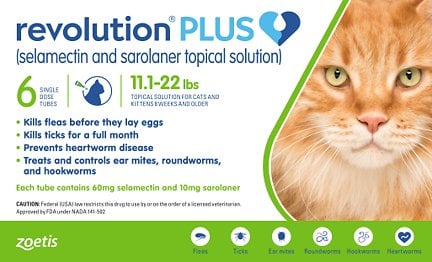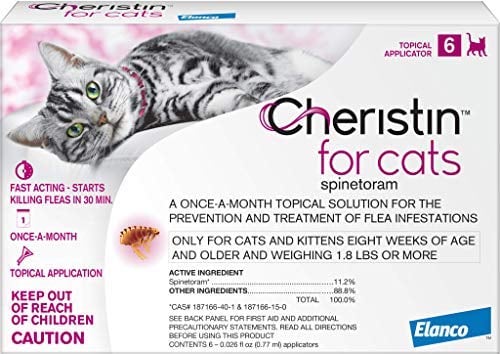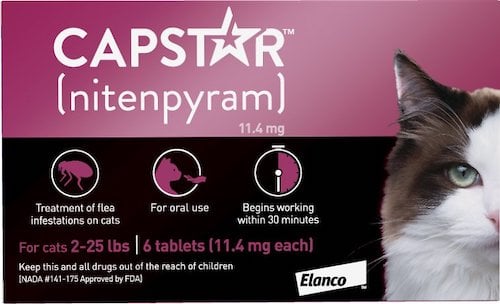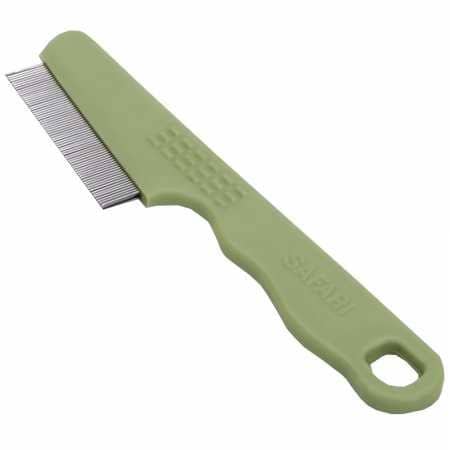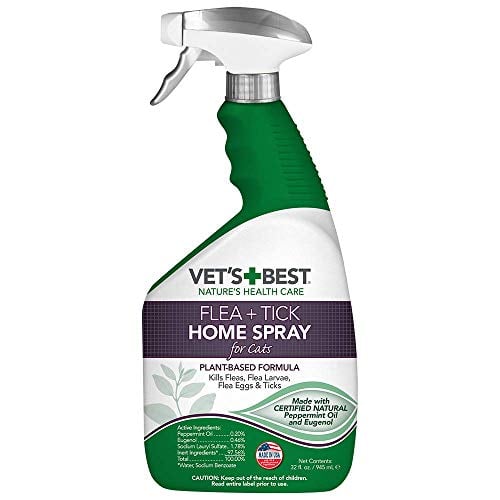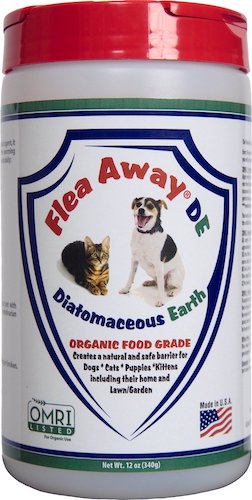- This post contains affiliate links. Read more here.
- Not a substitute for professional veterinary help.
If you’re a cat parent, chances are fleas are one of your worst nightmares. Their bites can cause your cat to scratch themselves frantically. Plus the fleas can infest your rugs and furniture—and once they’re established, it’s tough to break the cycle. The earlier you catch and treat a flea infestation, the better!
We’ve rounded up our favorite flea treatments and preventatives to keep your cat and your home bug free.
The Best Topical Cat Flea Treatments
Revolution Topical Solution for Cats (prescription only)
Revolution is a topical treatment that must be applied once a month to protect your cats against fleas. It’s on the pricey side, but it’s highly effective in both treating and preventing fleas, killing 98% of adult fleas within 36 hours and stopping eggs from hatching. It also protects against heartworm and roundworm.
It requires a prescription from your vet, and it’s important to purchase the correct dosage for your cat’s weight. The active ingredient is Selamectin, and each pack contains six single-dose tubes.
Key features:
- Applied once per month
- Kills 98% of adult fleas within 36 hours
- Protects against heartworm and roundworm
- On the pricier side of flea treatments
- Prescription required
Cheristin for Cats Topical Flea Treatment
If you want to see some flea-killing action fast, this product claims to start eliminating bugs in just 30 minutes, killing 98% of fleas within just 12 hours. This topical treatment (applied to the back of the neck) is made from a molecule called spinetoram, which occurs naturally in bacteria in the soil. Formulated specifically for cats, this solution is gentle enough for cats that are only eight weeks old but also lasts for an entire month.
Key features:
- Applied once per month
- Kills 98% of fleas within 12 hours
- No prescription required
Natural Chemistry Flea Shampoo for Cats
If you want to try a natural solution, this shampoo is a popular choice. Follow the directions for applying and rinsing off the shampoo. You can repeat the treatment once a week until the cat is free of fleas. (Note that you should also wash the cat’s bedding to remove flea eggs and clean the house thoroughly.) Active ingredients: cinnamon oil, clove oil, and cedar oil.
Key features:
- Natural ingredients
- Shampoo once per week until fleas are gone
- Less effective than traditional medications, though anecdotally successful in mild cases
The Best Oral Flea Treatments for Cats
Capstar Fast-Acting Oral Flea Treatment
If your cat rocks at taking medication orally, then this flea treatment will be a treat. Just one dose will start killing fleas within 30 minutes, which is why many reviewers rave that this treatment is the way to go. Kitties need to be two pounds or greater and at least four weeks old in order to take it. The pill can be given once a day (with or without food) until your flea problem goes away. Active ingredient: Nitenpyram.
Key features:
- One pill is designed to kill all fleas (though further doses can be offered if problem persists)
- Treats active flea infestations; not for use as a preventative
- No prescription required
Best Flea Comb for Cats
Safari Cat Flea Comb
Though they’re a bit old school, flea combs are still an effective treatment to remove fleas from your cat’s fur—and they’re especially useful for offering relief as other treatments work their magic. This sturdy comb seems to have the teeth spaced just right for catching those fleas and for giving your kitty’s coat a soothing brush-through. Both the company and reviewers recommend keeping a cup of water with a bit of dish soap close by for dipping the comb into between strokes. Happy bug-hunting!
Key features:
- No chemicals or oils
- Teeth designed for optimal flea removal
- Manual flea removal can offer a cat immediate relief (though it may not solve the long-term problem)
Best Cleaning Products for Fleas in the Home
Vet’s Best Flea and Tick Home Spray for Cats
Designed to be sprayed around the house, this formula kills fleas, flea larvae, flea eggs, and ticks. It doesn’t contain any of the harsh chemicals that are bad for your feline—just certified natural oils and other safe ingredients. Use this spray on your furniture, crates, pillows, blankets, and other areas of the house.
Key features:
- Plant-based formula containing peppermint and clove oil
- Good for furniture and carpets
- Bonus: repels mosquitos
Flea Away Food-Grade Diatomaceous Earth
If your home is experiencing a flea infestation, this popular powder can be sprinkled on carpets, furniture, and baseboards. (Do not sprinkle it directly on your cat, and be careful not to inhale it!) It kills fleas by drying them out, and you can vacuum up the powder three days later and throw away your vacuum bag or empty and clean the canister. (It’s called food-grade because it is used to keep feed for large animals, such as horses, dry.)
Key features:
- Kills fleas on carpets and furniture
- Safe for use around the house
- Do not apply directly to a cat
How Do I Know If My Cat Has Fleas?
Cats with fleas will look itchy. If your cat is doing the below regularly, it’s a good idea to get out the flea comb and find out for certain:
- Scratching their head and ears
- Chewing and biting themselves
- Licking excessively, especially around their legs
- Experiencing red and irritated skin (dermatitis)
- Showing some bald patches from all the scratching
To check if your cat has fleas, use an inexpensive flea comb to hunt for fleas and black specks of “flea dirt” (feces). These are most commonly found at the base of a cat’s spine (where the tail begins), on the cat’s back, and on the belly.
Fleas can be fatal to young kittens, so if your kitten has any of these symptoms, call your veterinarian immediately. For healthy adult cats, it’s time for flea treatment.
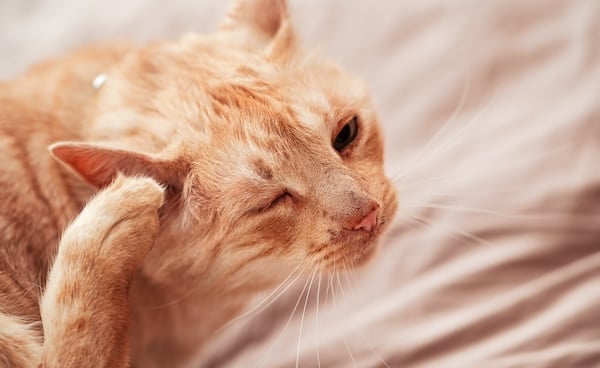
Lubo Ivanko via iStock
Are Flea Treatments Safe?
Fortunately, there are lots of safe ways to get rid of fleas.
It can be tempting to pick “natural” remedies because they seem safer—but be aware that while natural flea prevention tactics can sometimes help keep the bugs away, they can’t always deal with a serious case; you may want to consider treatments that contain synthetic chemicals.
The Food and Drug Administration and the Environmental Protection Agency regulate flea products and conduct reviews of a product’s safety for the animal, people in contact with the animal, and the environment. These two agencies must approve flea products before they can be sold or marketed. We also keep a watchful eye on product recalls and the news to monitor potentially harmful products up for investigation.
Make sure the flea medicine you choose is specifically for cats and that the dosage you use is correct for your cat’s weight. Be very careful if you are also treating your dog for fleas—some flea treatments that are perfectly safe for dogs can be fatal if your cat licks the dog’s fur after the dog has been treated.
It’s also a good idea to check with your veterinarian to make sure the treatment you’re using is suitable for your particular cat, especially if your kitty has any health conditions or is taking other medication.

Nils Jacobi via iStock
What About Flea Collars—Are They Safe?
Flea collars claim to give off chemicals that either repel fleas or kill them even before they bite your cat. They’ve come under scrutiny in recent years, which has made many pet parents wary.
Dr. David Littlejohn of Pawscessories says that flea collars are generally safe but species-dependent; cats should never wear flea collars designed for dogs and vice versa.
It’s possible that your pet could have an allergy to the chemicals used on a flea collar—but that’s true of almost any flea treatment or medication, which is why it’s a good idea to check in with your vet before starting a course of treatment or choosing a preventative.
The bigger issue with flea collars, Dr. Littlejohn told us, is that they’re typically not very effective. Their affordability makes them attractive to pet parents, but they offer a false sense of security. “How well they actually protect pets from fleas is up for debate,” Dr. Littlejohn says, “but over time they’re becoming increasingly obsolete compared to oral or topical treatments.”
Those oral and topical treatments may be more expensive—but according to Dr. Littlejohn, they’re also much more effective.
Types of Cat Flea Treatments and Preventatives
You’ll find a wide range of flea repellants and flea treatments on the market.
The most effective ones are topical treatments applied to one spot on the cat’s skin (usually at the back of the neck). These include:
- Fipronil (used in Frontline Plus)
- Selamectin (used in Revolution)
- Fluralaner (used in Bravecto)
Also effective are pills (oral treatments) such as Capstar and Comfortis, which make your cat’s blood poisonous to biting fleas—without harming your cat.
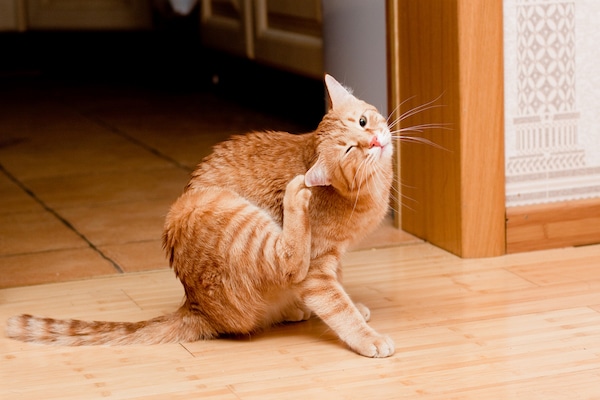
foaloce via iStock
Experts note that simply treating your cats and other pets is usually not enough to rid your house of a flea infestation. You will need to vacuum furniture weekly, wash rugs and quilts, and clean cat beds. Spray treatments for rugs and furniture can help. If the infestation persists, you may even need to call in a flea service that will treat your rugs and furniture.
Do Indoor Cats Need Flea Preventatives?
A lot of pet parents think that indoor cats don’t need flea prevention—after all, how would an indoor cat get fleas?
Unfortunately, it’s surprisingly easy. A fellow outdoor pet like a dog can bring fleas in on their coat, and so can humans. Because fleas don’t typically pick humans as hosts, we don’t think of ourselves as potential carriers. But just because we’re not attractive permanent housing doesn’t mean a flea won’t hitch a ride. Once in the house, fleas will quickly target any pets living there and lay eggs.
That’s why it’s a good idea for even indoor cats to take preventative flea medication, especially during flea and tick season.
We’ve rounded up our favorite spot-treatments, oral medications for your cat, and sprays for your household to help your feline friend stay flea-free. Before you buy, remember to talk with your vet to make sure your treatment of choice is appropriate for your particular cat.

